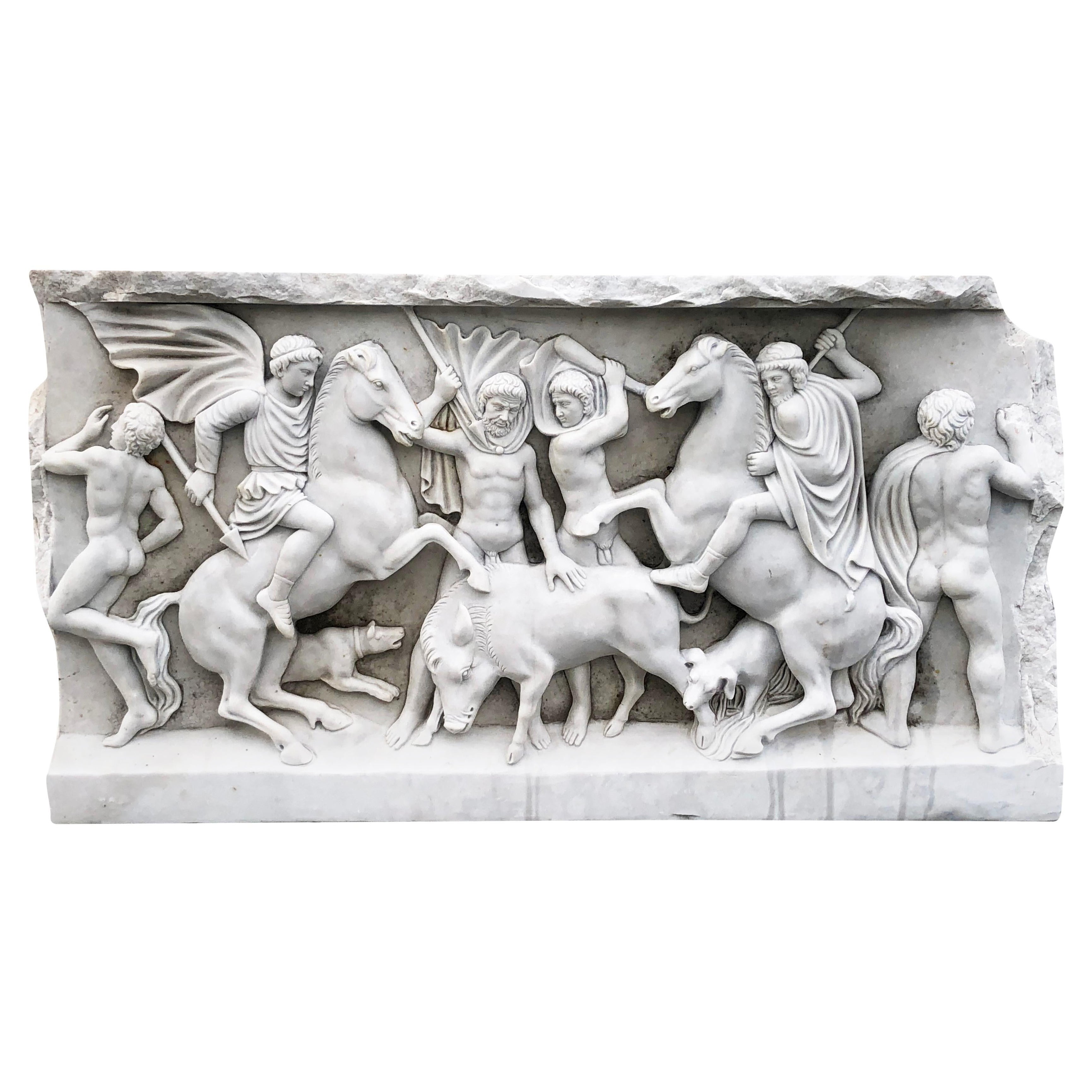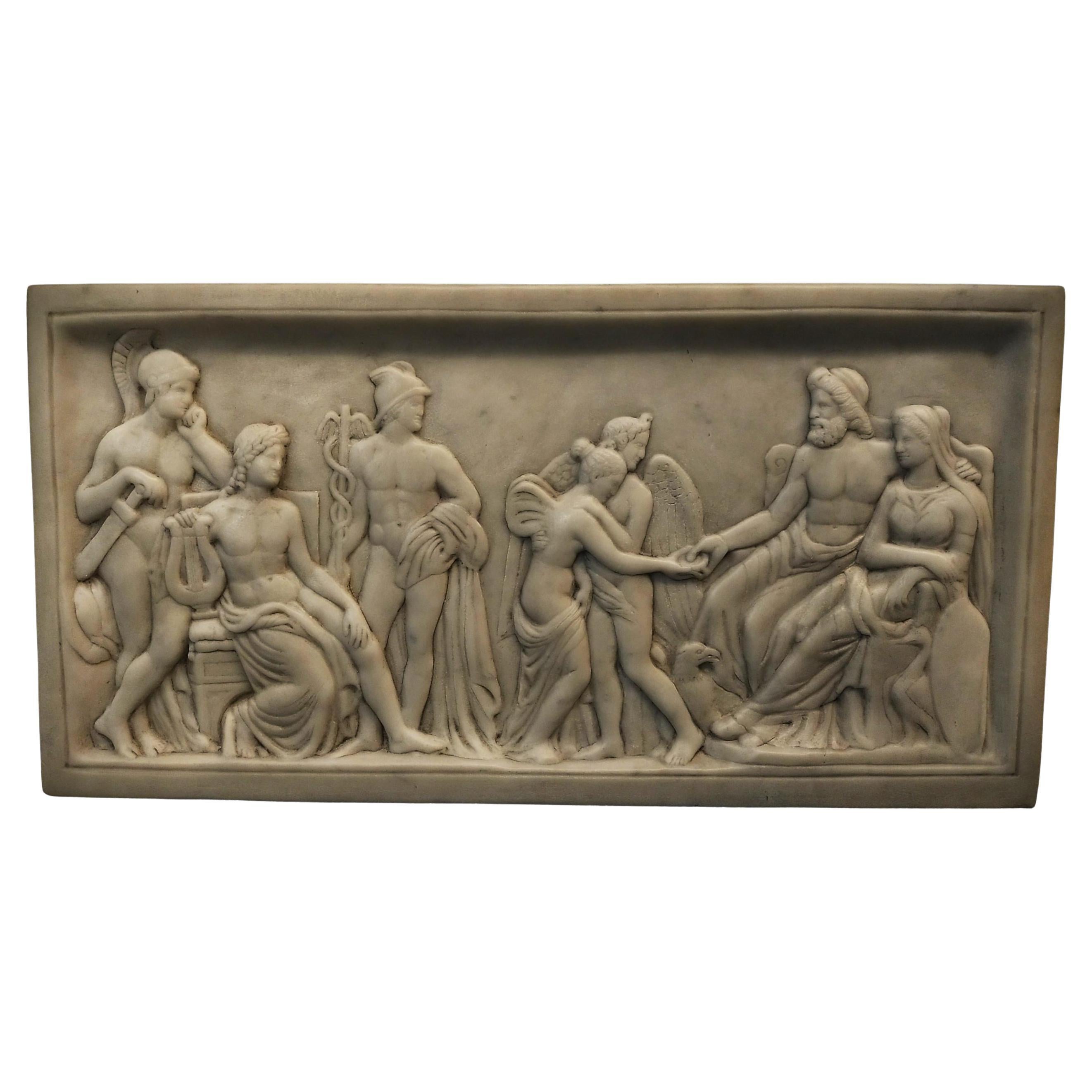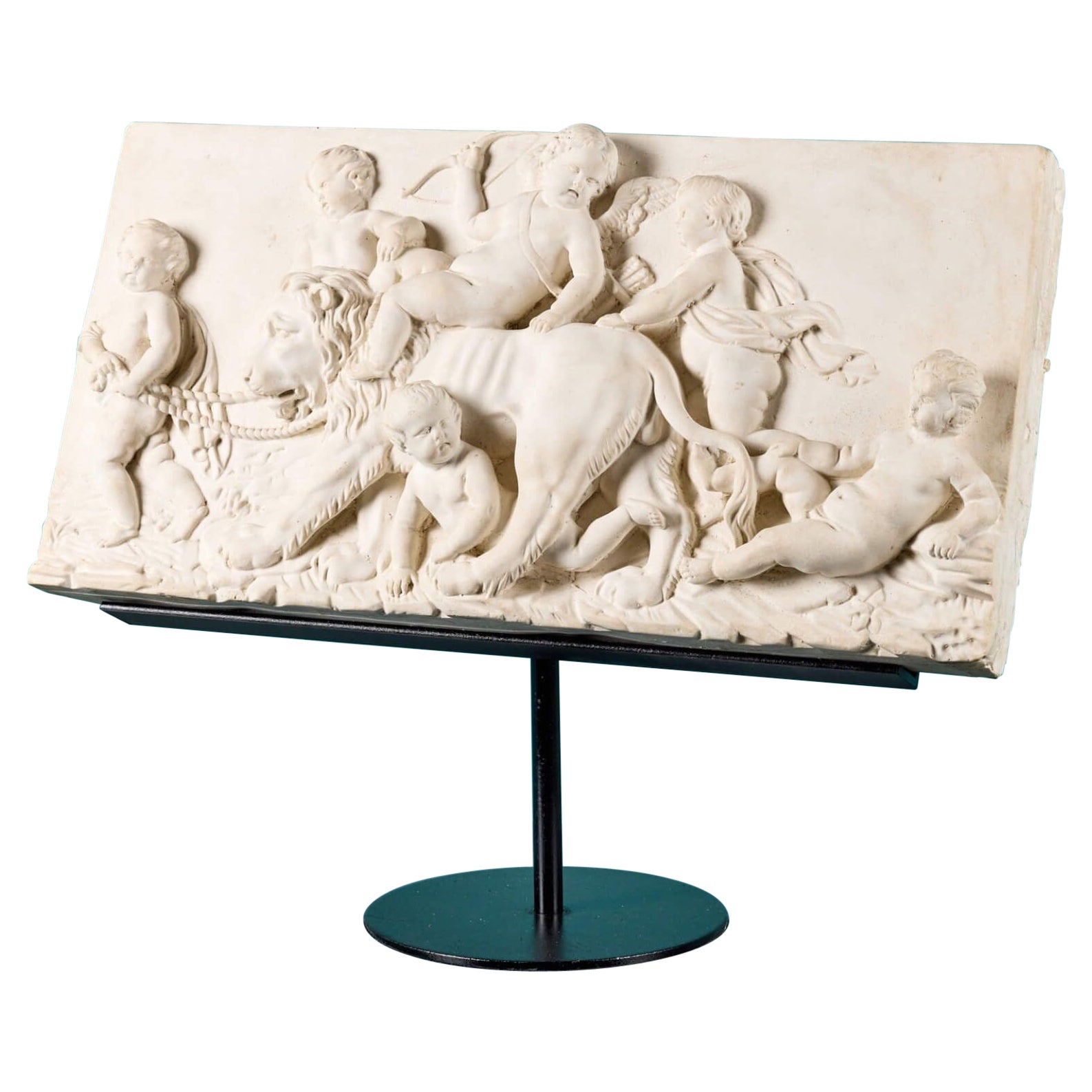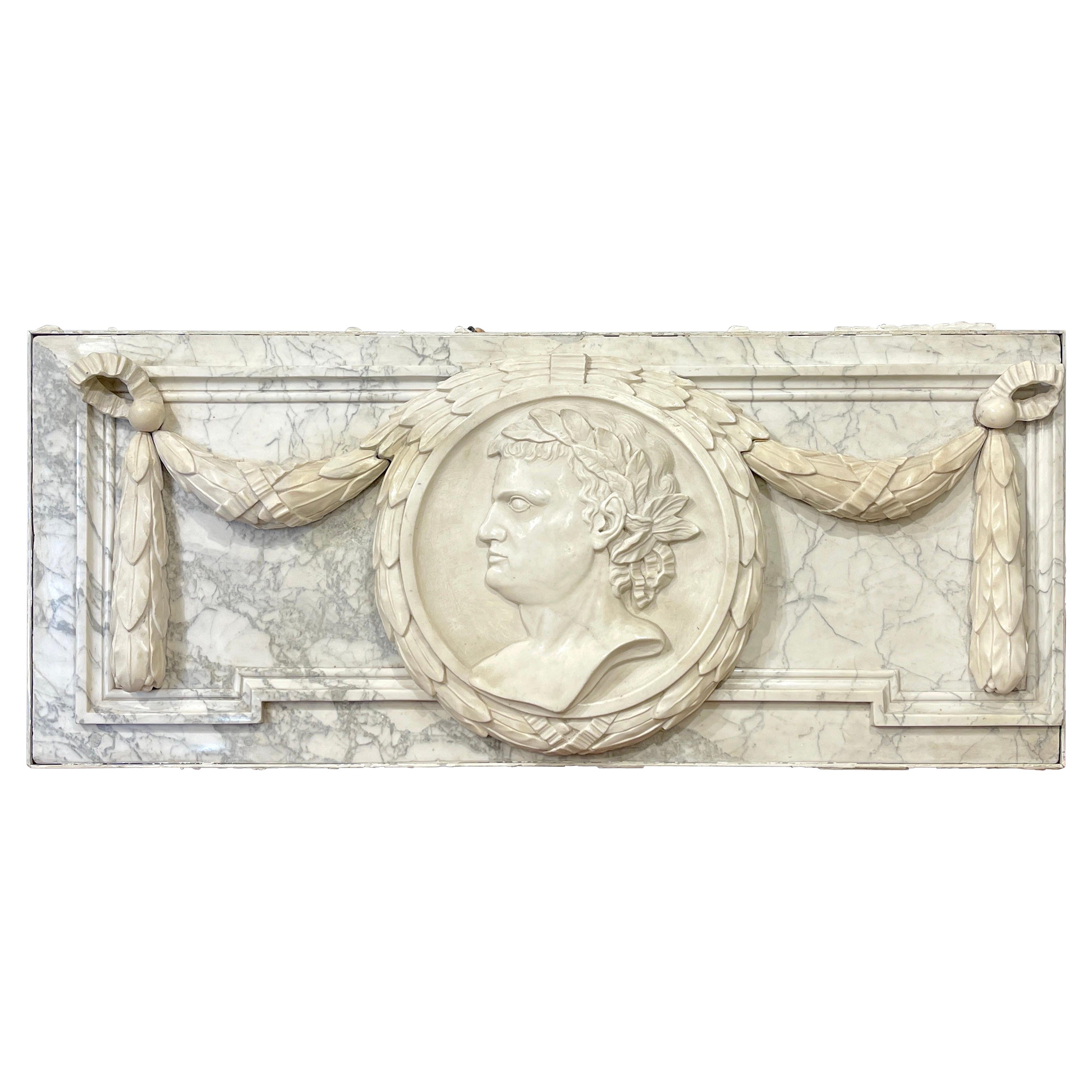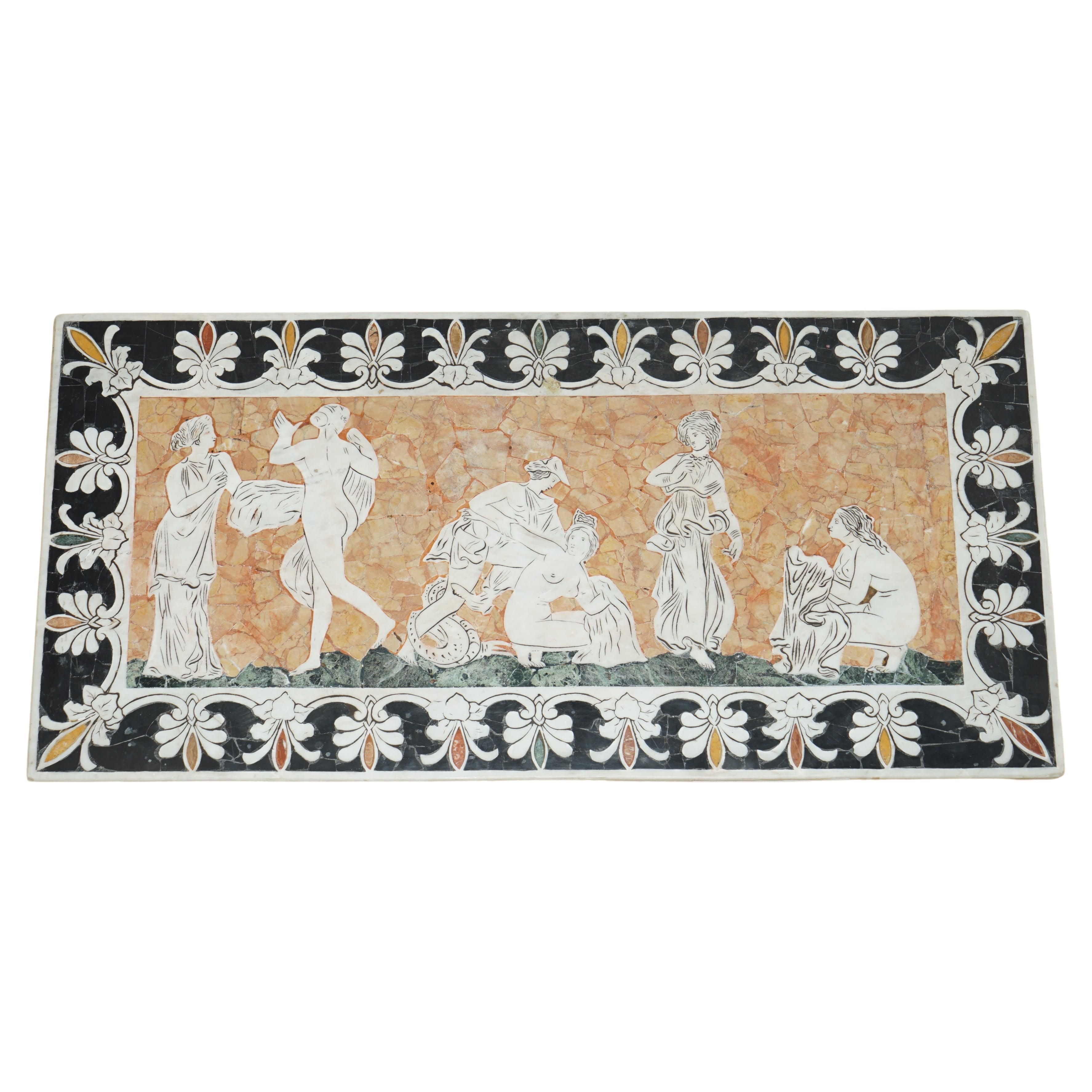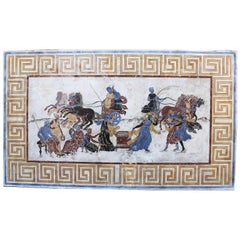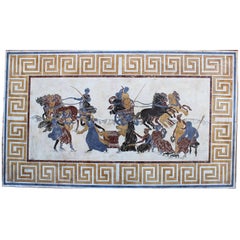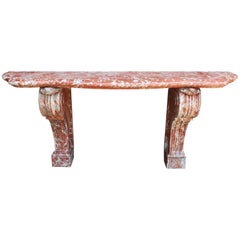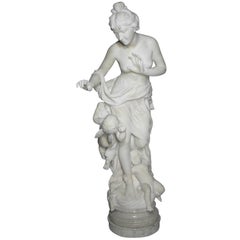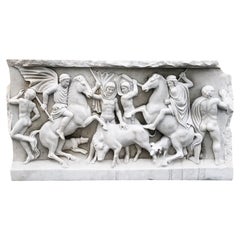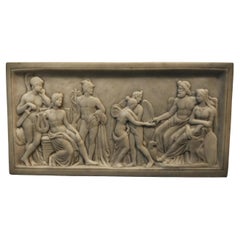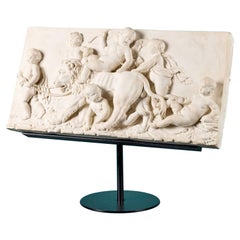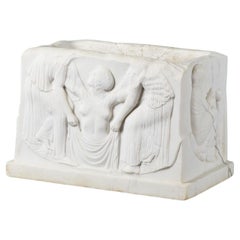Items Similar to Italian 19th Century Greco-Roman Style Marble Bas-Relief Frieze, Coffee Table
Video Loading
Want more images or videos?
Request additional images or videos from the seller
1 of 13
Italian 19th Century Greco-Roman Style Marble Bas-Relief Frieze, Coffee Table
$48,950
$124,50060% Off
£37,198.70
£94,611.6160% Off
€42,812.87
€108,890.7560% Off
CA$70,049.94
CA$178,165.8360% Off
A$76,964.80
A$195,753.1860% Off
CHF 39,690.26
CHF 100,948.6760% Off
MX$922,116.28
MX$2,345,321.2960% Off
NOK 503,944.13
NOK 1,281,737.3760% Off
SEK 472,931.08
SEK 1,202,858.4260% Off
DKK 319,752.16
DKK 813,261.3660% Off
About the Item
A Very Fine Italian 19th century Greco-Roman style carved Carrara marble bas-relief Frieze, after the antique. The finely carved white marble frieze in relief, depicting a mythological scene of daily life in Ancient Rome in a Roman baths setting; with figures of Pan playing flute to dancing maidens, Roman Gods, children, a plebeian worker and a herm. The frieze has now been framed within a modern rouge Royal marble frame and converted into a twin-pedestal coffee table with a glass top. The coffee table setting is modern. The Carrara marble frieze is circa 1860-1870*.
Bas-relief is a type of carved relief (sculpture) that has less depth to the faces and figures than they actually have, when measured proportionately (to scale). This technique keeps the natural shapes of the figures and allows the work to be seen from many angles without twisting the figures themselves.
There is a continuation of the bas-relief technique into the next category, altorilievo, or high relief. High relief makes deeper images than bas-relief. Instead of shallow backgrounds that are a few inches (cm) deep at most, they can be up to several feet (a few meters) deep in altorilievo.
Some of the best examples of bas-relief are the Assyrian Lion Hunt Reliefs, which are housed at the British Museum. The attention to detail and appearance of the lions moving make them stand out, especially for the time period they were made in.
Ancient Roman bathing played a major part in ancient Roman culture and society. It was one of the most common daily activities and was practiced across a wide variety of social classes. Though many contemporary cultures see bathing as a very private activity conducted in the home, bathing in Rome was a communal activity. While the extremely wealthy could afford bathing facilities in their homes, private baths were very uncommon, and most people bathed in the communal baths (thermae - therms). In some ways, these resembled modern-day destination spas as there were facilities for a variety of activities from exercising to sunbathing to swimming and massage.
Such was the importance of baths to Romans that a catalogue of buildings in Rome from 354 AD documented 952 baths of varying sizes in the city. Public baths became common throughout the empire as a symbol of "Romanitas" or a way to define themselves as Roman. They were some of the most common and most important public buildings in the empire as some of the first buildings built after the empire would conquer a new area.
Although the wealthiest Romans might set up a bath in their townhouses or their country villas, heating a series of rooms or even a separate building especially for this purpose, and soldiers might have a bathhouse provided at their fort (as at Cilurnum on Hadrian's Wall, or at Bearsden fort), they still often frequented the numerous public bathhouses in the cities and towns throughout the empire.
Small bathhouses, called balneum (plural balnea), might be privately owned, while they were public in the sense that they were open to the populace for a fee. Larger baths called thermae were owned by the state and often covered several city blocks. The largest of these, the Baths of Diocletian, could hold up to 3,000 bathers. Fees for both types of baths were quite reasonable, within the budget of most free Roman males.
Some of the earliest descriptions of western bathing practices came from Greece. The Greeks began bathing regimens that formed the foundation for modern spa procedures. These Aegean people utilized small bathtubs, washbasins, and foot baths for personal cleanliness. The earliest such findings are the baths in the palace complex at Knossos, Crete, and the luxurious alabaster bathtubs excavated in Akrotiri, Santorini; both date from the mid-2nd millennium BC. They established public baths and showers within their gymnasium complexes for relaxation and personal hygiene.
Greek mythology specified that certain natural springs or tidal pools were blessed by the gods to cure disease. Around these sacred pools, Greeks established bathing facilities for those desiring to heal. Supplicants left offerings to the gods for healing at these sites and bathed themselves in hopes of a cure. The Spartans developed a primitive steam bath. At Serangeum, an early Greek balneum (bathhouse, loosely translated), bathing chambers were cut into the hillside into the rock above the chambers held bathers' clothing. One of the bathing chambers had a decorative mosaic floor depicting a driver and chariot pulled by four horses, a woman followed by two dogs, and a dolphin below. Thus, the early Greeks used natural features, but expanded them and added their own amenities, such as decorations and shelves. During the later Greek civilization, bathhouses were often built in conjunction with athletic fields.
*: The marble frieze may even be an earlier piece
Frieze Width: 55 3/4 inches (141.6 cm)
Frieze Height: 12 1/2 inches (37.8 cm)
Frieze Depth: 4 inches (10.2 cm)
Coffee Table Width: 60 1/4 inches (153 cm)
Coffee Table Height: 17 inches (43.2 cm)
Coffee Table Height with Glass Top: 17 1/4 inches (43.8 cm)
Coffee Width: 17 3/8 inches (44.2 cm)
Coffee Table Width with Glass Top: 21 1/2 inches (54.6 cm).
- Dimensions:Height: 17.25 in (43.82 cm)Width: 64 in (162.56 cm)Depth: 21.5 in (54.61 cm)
- Style:Greco Roman (In the Style Of)
- Materials and Techniques:
- Place of Origin:
- Period:
- Date of Manufacture:circa 1860-1870
- Condition:Repaired: Overall current condition is very good. There is a professional restoration to the center of the frieze which has been reinforced with steel bars from the back of the frieze. Minor hairlines and age losses, finely detailed carving and very decorative. Wear consistent with age and use. Minor losses. Minor fading. Overall current condition is very good. There is a professional restoration to the center of the frieze which has been reinforced with steel bars from the back of the frieze. Minor hairlines and age losses, finely detailed carving and very decorative.
- Seller Location:Los Angeles, CA
- Reference Number:Seller: Ref.: A2672 - Lot 114531stDibs: LU1796233082582
About the Seller
5.0
Vetted Professional Seller
Every seller passes strict standards for authenticity and reliability
Established in 1982
1stDibs seller since 2016
136 sales on 1stDibs
Typical response time: <1 hour
- ShippingRetrieving quote...Shipping from: Los Angeles, CA
- Return Policy
Authenticity Guarantee
In the unlikely event there’s an issue with an item’s authenticity, contact us within 1 year for a full refund. DetailsMoney-Back Guarantee
If your item is not as described, is damaged in transit, or does not arrive, contact us within 7 days for a full refund. Details24-Hour Cancellation
You have a 24-hour grace period in which to reconsider your purchase, with no questions asked.Vetted Professional Sellers
Our world-class sellers must adhere to strict standards for service and quality, maintaining the integrity of our listings.Price-Match Guarantee
If you find that a seller listed the same item for a lower price elsewhere, we’ll match it.Trusted Global Delivery
Our best-in-class carrier network provides specialized shipping options worldwide, including custom delivery.More From This Seller
View AllItalian 19th-20th Century Neoclassical & Greco-Roman Style Scagliola Wall Plaque
Located in Los Angeles, CA
A large Italian 19th-20th century neoclassical and Greco-Roman style architectural scagliola wall plaque depicting chariots, horses, allegorical maidens and gods, inlaid and painted ...
Category
Antique Early 1900s Italian Greco Roman Decorative Art
Materials
Other
$9,450 Sale Price
25% Off
Italian 19th-20th Century Neoclassical & Greco-Roman Style Scagliola Wall Plaque
Located in Los Angeles, CA
A large Italian 19th-20th century neoclassical and Greco-Roman style architectural Scagliola wall plaque depicting chariots, horses, allegorical maidens and gods, inlaid and painted ...
Category
Antique Early 1900s Italian Greco Roman Decorative Art
Materials
Other
$12,985 Sale Price
25% Off
Palatial French 19th Century Louis XV Style Carved Rouge Royal Marble Console
Located in Los Angeles, CA
A very fine and palatial French, 19th century Louis XV style carved rouge royal (Namur, Belgium) marble wall Console Table. The elongated serpentine thick marble top raised and suppo...
Category
Antique 19th Century French Louis XV Console Tables
Materials
Marble
$39,850 Sale Price
38% Off
Italian 19th-20th Century Life-Size Marble Sculpture Titled "Searching for Love"
By Vito Pardo
Located in Los Angeles, CA
A very fine museum quality Italian 19th-20th century life-size marble sculpture titled "Searching for Love" by Vito Pardo (Italian, born in Venice in 1872) Depicting a semi-nude life...
Category
Antique Early 1900s Italian Rococo Figurative Sculptures
Materials
Marble, Bronze
$219,600 Sale Price / set
44% Off
Lifesize French 19th-20th Century Carved Marble Sculpture of "Venus and Cupid"
By Félix Charpentier
Located in Los Angeles, CA
A lifesize French 19th-20th century carved marble sculpture of "Venus and Cupid" In the manner of Felix Maurice Charpentier (French, 1858-1924). The tall and slender nude figure of a...
Category
Antique Early 1900s French Greco Roman Figurative Sculptures
Materials
Marble
Italian 19th-20th Century Marble Group "Allegory to Music" Children's Orchestra
Located in Los Angeles, CA
A very fine and large Italian 19th-20th century Carrara marble group "Allegory to Music" depicting five Bacchic putti musicians playing various instruments. The finely carved Palatia...
Category
Antique Early 1900s Italian Beaux Arts Figurative Sculptures
Materials
Carrara Marble
$98,985 Sale Price
31% Off
You May Also Like
19th Century British Carrara Marble Roman Relief Sculpture - Antique Relief
Located in West Palm Beach, FL
This Carrara marble bas relief sculpture was hand carved in England in the late 1800s, in good condition. The antique relief sculpture depicts...
Category
Antique 19th Century English Figurative Sculptures
Materials
Carrara Marble
Sculpture, Relief of Mythological Scene from the Neoclassical Period
Located in Rome, IT
Sculpture, Relief of mythological scene from the Neoclassical period
ADDITIONAL PHOTOS, INFORMATION OF THE LOT AND SHIPPING INFORMATION CAN BE REQUESTED BY SENDING AN EMAIL
in Carra...
Category
Antique 19th Century Italian Figurative Sculptures
Materials
Marble
Neoclassical Style Composition Plaque
Located in Wormelow, Herefordshire
An Neoclassical composition plaque, from the Tucker collection, made by British make-up artist Christopher Tucker.
This decorative piece is a copy of a Georgian chimney piece, origi...
Category
Late 20th Century English Neoclassical Mounted Objects
Materials
Composition, Metal, Steel
Antique Marble Carving of the Ludovisi Throne
Located in Wormelow, Herefordshire
Antique Marble Carving of the Ludovisi Throne. A Grand Tour style carving of the “Ludovisi Throne”. Aphrodite is attended by two handmaidens as she rises out the surf. The original Greek sculpture was carved circa 460 BC.
Ludovisi Throne
When discovered the Ludovisi Throne was thought to be the seat from a statue of a colossal god, but the definite function is unknown. It may have been a throne, an altar, or enclosure for ritual sacrifices...
Category
Antique Late 19th Century Sculptures and Carvings
Materials
Marble, Statuary Marble
19th Century Italian Carved Marble Architectural Frieze Sculpture of Caesar
Located in West Palm Beach, FL
19th Century Italian carved marble Architectural Frieze Sculpture of Caesar, Of rectangular form the finely carved Carrera Marble 50" x 20" slab w...
Category
Antique Late 19th Century Italian Classical Roman Architectural Elements
Materials
Carrara Marble, Statuary Marble, Steel
$14,213 Sale Price
24% Off
Very Rare Antique Italian circa 1860 Marble Mosaic Neoclassical Panel Table Top
Located in West Sussex, Pulborough
We are delighted to offer for sale this very rare and collectable antique Italian marble mosaic table top panel with Neoclassical figures
I have never seen another like this, to ...
Category
Antique 1860s Italian Neoclassical Tables
Materials
Marble
$4,938 Sale Price
20% Off
More Ways To Browse
Marble Frieze
Bas Relief Sculptures
Italian Relief
Antique Alligator
Carved Bas Relief
Relief Frieze
Hand Carved Frieze
Free Form Glass Coffee Table
Antique Crete
Set Of 3 Coffee Tables Marble
Antique Showers
Italian Bas Relief
19th Century Bas Relief
Roman Style Table
Antique Pedestal Coffee Table
Bas Relief Marble
Twin Coffee Table
Alligator Sculptures
